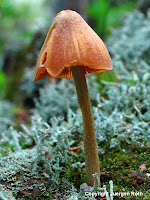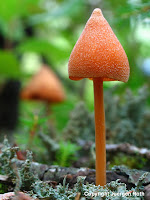 During my last photography tour to magical Acadia National Park in Maine on Mount Desert Island I decided to capture Otter Cliff despite bad weather conditions. The sky was very overcast and cloudy; rain was falling. From the park's loop road I pulled into one of the parking lots near Otter Cliff. Parking was a non issue because of the rain, and most people were exploring the town of Bar Harbor. I choose the last spot at the end of the parking lot and was immediately inspired by the green forest in front of me. Instead of making my way to the granite seacoast to photograph famous Otter Cliff, I climbed up a little ridge and a few yards into the woods. Here I positioned my tripod to capture the forest. Once satisfied, I started walking back towards the parking lot when I noticed this little tiny thing on the forest floor. Protected by moss and roots a 2 inch mushroom was arising. Instantly caught in the moment, I lowered my tripod to floor level without succeeding to achieve an attractive perspective of it. I was forced to take the camera off the tripod and hand-hold the camera while resting it on one of the tripod legs. This field adjustment brought the camera level really low and I achieved a more intimate composition of the little mushroom. In my first photograph I singled out the mushroom using the moss as a backdrop. I then decided to explore different views when I noticed a second mushroom in near distance.
During my last photography tour to magical Acadia National Park in Maine on Mount Desert Island I decided to capture Otter Cliff despite bad weather conditions. The sky was very overcast and cloudy; rain was falling. From the park's loop road I pulled into one of the parking lots near Otter Cliff. Parking was a non issue because of the rain, and most people were exploring the town of Bar Harbor. I choose the last spot at the end of the parking lot and was immediately inspired by the green forest in front of me. Instead of making my way to the granite seacoast to photograph famous Otter Cliff, I climbed up a little ridge and a few yards into the woods. Here I positioned my tripod to capture the forest. Once satisfied, I started walking back towards the parking lot when I noticed this little tiny thing on the forest floor. Protected by moss and roots a 2 inch mushroom was arising. Instantly caught in the moment, I lowered my tripod to floor level without succeeding to achieve an attractive perspective of it. I was forced to take the camera off the tripod and hand-hold the camera while resting it on one of the tripod legs. This field adjustment brought the camera level really low and I achieved a more intimate composition of the little mushroom. In my first photograph I singled out the mushroom using the moss as a backdrop. I then decided to explore different views when I noticed a second mushroom in near distance.I again used
 one of the tripod legs to stabilize and minimize camera shaking. I kept the second mushroom completely out of focus and used the roots on the forest ground as leading lines to it. Because of the same color the viewer then returns back to the main mushroom object that completes the viewers journey through the photograph.
one of the tripod legs to stabilize and minimize camera shaking. I kept the second mushroom completely out of focus and used the roots on the forest ground as leading lines to it. Because of the same color the viewer then returns back to the main mushroom object that completes the viewers journey through the photograph.A polarizing filter minimized the glare on the mushroom tips and saturated the forest greens. Aperture in both photographs was set to f/7.1 that resulted in 1/3 and 1/5 seconds exposure time. In the post processing steps I made minimal color and lighting adjustments before sharpening.

Awesome Mushroom photography tips! Saw you on twitter, awesome photos. --StemMunncher
ReplyDeleteThanks for commenting on my macro mushroom photography Stem ... glad you like it!
ReplyDelete